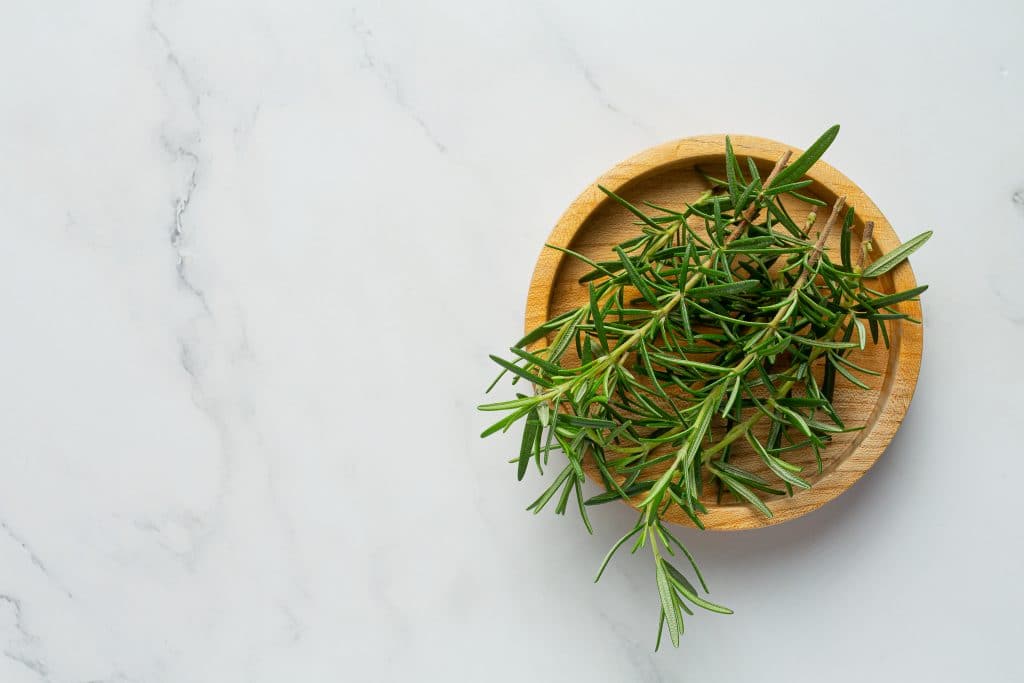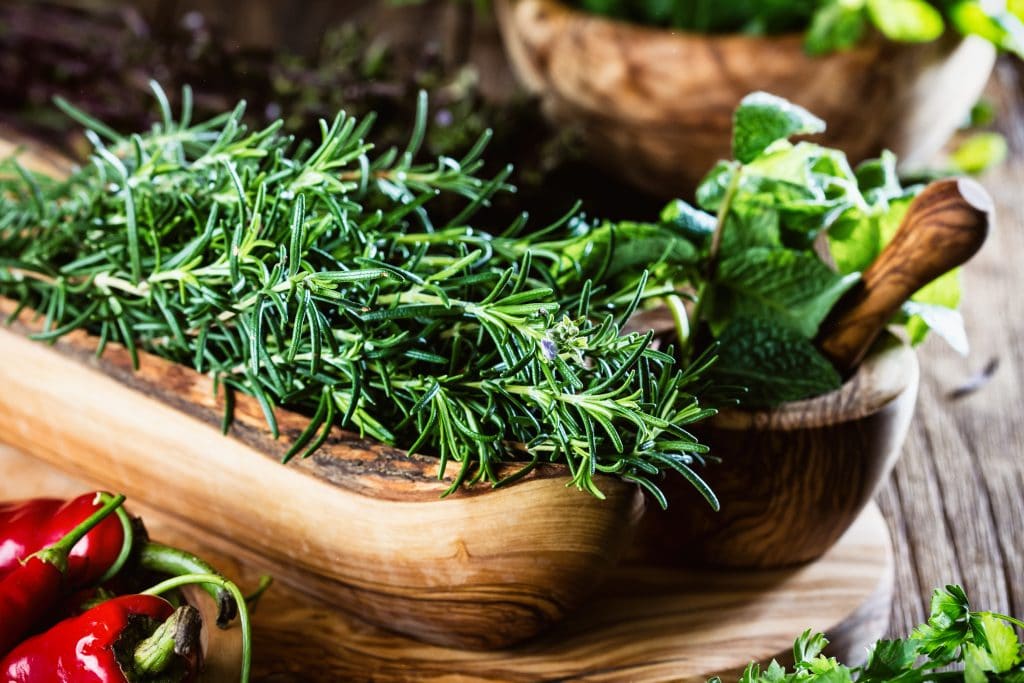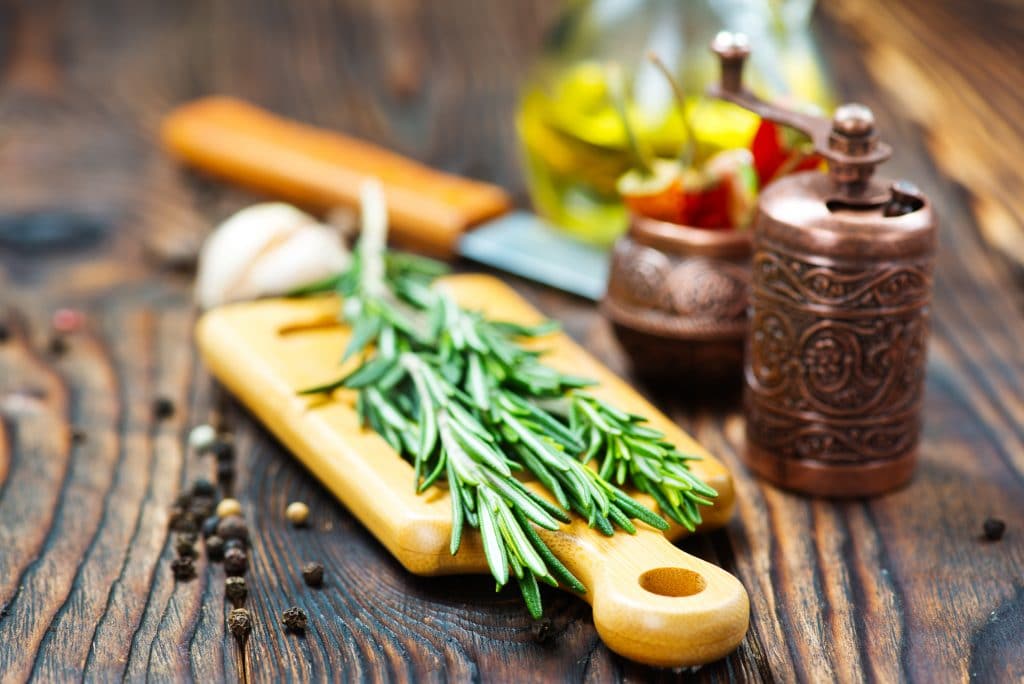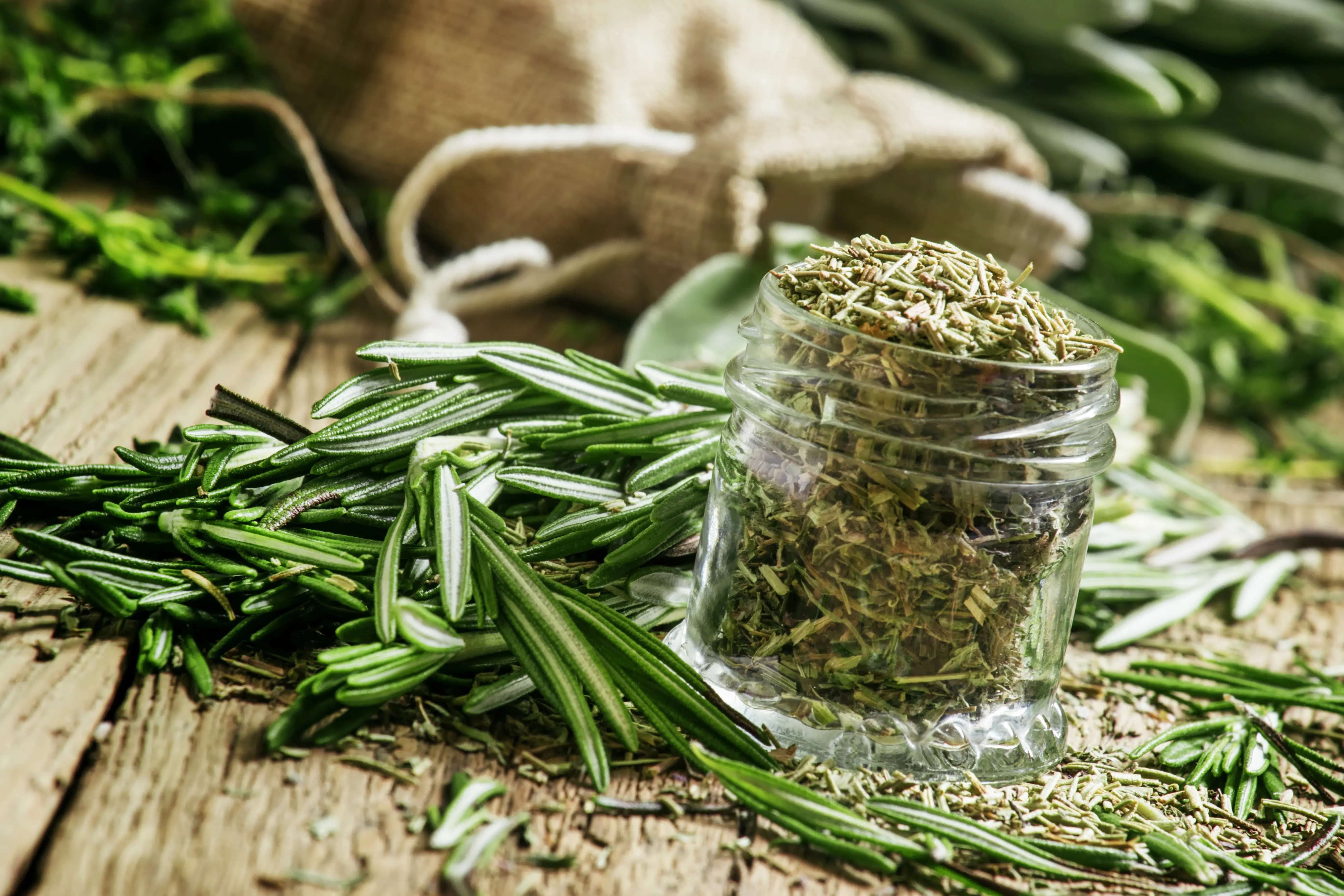What Does Rosemary Taste Like?
Important Note: When you buy through our links, we may earn a commission. As an Amazon Associate we earn from qualifying purchases. Content, pricing, offers and availability are subject to change at any time - more info.
Rosemary is a fragrant herb we often use to give a rich Mediterranean flavor to dishes. The dried or fresh leaves of rosemary are an excellent addition to many meat dishes, like lamb, chicken, and even fish. If you’ve never used rosemary in your cooking before, you may be wondering what this wonderful herb tastes like, how to use it, and the food with which it goes best.
The herb rosemary imparts a distinctive piney flavor to food. A member of the Lamiaceae family, rosemary has a sharp scent, and the flavor is woody and sage-like with hints of lemon and mint. The taste is intense and does not get lost in the cooking process but can become bitter if overcooked.
Different varieties of rosemary will also have slightly different flavors, which makes the taste even harder to describe. It can be used fresh or dried, though fresh rosemary will usually have a more intense, deeper flavor. This herb is very strong, and using too much of it can overwhelm the other flavors in your cooking, so we’ll discuss the different ways to use rosemary in your dishes and how to keep it tasting at its best.
- Taste of Rosemary
- Sweet or Bitter?
- How To Use It In Cooking?
- Using Dried Rosemary Instead of Fresh
- What Does It Taste Best With?
- How to Select Rosemary?
- Drying Fresh Rosemary For Taste
- How To Prepare Fresh Rosemary?
- How To Store Fresh Rosemary?
- How To Store Dried Rosemary?
- How Much Rosemary To Use When Cooking?
- The Health Benefits of Rosemary
- Alternatives to Rosemary
- So, What Does Rosemary Taste Like?
Taste of Rosemary

A Mediterranean native, rosemary has been used to add flavor to food since ancient Roman and Greek times and has been used for its medicinal properties even longer than that. Not only does it have medical benefits, but its fresh smell has also made it an addition to perfumes, where rosemary oil lends a distinctive aroma to everything from incense to cleaning products to body products.
But the most common usage for the herb rosemary is for its intense piney flavor, particularly in traditional Mediterranean foods. The slightly bitter, almost eucalyptus-like smell and taste are characteristic of rosemary and complement many types of meat, such as roast lamb, chicken, and pork. It’s often an essential ingredient in stuffing recipes, and the smoky flavor goes perfectly with a bbq.
As with most herbs, fresh rosemary will have a fuller, more complex taste, but it is not wrong to use dried if fresh is not available. Rosemary is one of the herbs that retain a lot of their flavor even when dried, and the dried leaves are excellent substitutes if fresh is not available.
Rosemary doesn’t lose its flavor during the cooking process; heat increases the flavor profile, and the oils are released into the liquid of food like stews and soups. It also makes a great addition to baked goods and loaves of bread like this mouth-watering Focaccia Genovese.
Rosemary varieties can have slightly different taste profiles. While we commonly use traditional rosemary in most recipes, other types like Tuscan Blue or Sisinghurt Blue have piney lemon-like or deep smoky flavors. You may want to experiment using different rosemary varieties for different dishes, such as lighter, fresher rosemary types on fish and cakes and the stronger woodier types on barbeques and in roast stuffings.
Sweet or Bitter?
Aromatic rosemary is not sweet, but the lemon pine flavor can pair well with a sweet taste. An exciting flavor combination is to pair rosemary with dark chocolate or orange. Pairing rosemary with these different sweeter tastes can help the savory herb highlight the richness of chocolate or the citrus tang of the fruits.
If you overcook rosemary, you risk it becoming woody and bitter. Some people find the taste of overcooked rosemary a bit medicinal. One way to avoid this is not to add rosemary at the start of the cooking process if you know the food will be cooking for a very long time.
To keep the rosemary taste light and vibrant, you may want to add fresh or dried rosemary only towards the end, in the final few minutes of cooking.
How To Use It In Cooking?
You can use rosemary as a seasoning in many meat dishes, and it goes particularly well with chicken and lamb. Oily fish and rosemary also pair very well.
One way of adding rosemary flavor to food such as salads is to make your own rosemary-infused olive oil by adding a ¼ cup dry, fresh rosemary leaves to 1 cup olive oil and gently heating the oil before leaving it to infuse for an hour.
You can easily store this rosemary-infused oil in a clean jar in your fridge for approximately 1 week. It makes an excellent oil for salad dressings or roast dishes such as potatoes, fish, and chicken.
When using whole sprigs of fresh rosemary in recipes such as stews, it’s easy to remove the entire herb before serving. Other recipes will call for only the leaves, easily removed from the woody stems, whether fresh or dried.
Using Dried Rosemary Instead of Fresh
If a recipe calls for fresh rosemary, it is easy to substitute with dried rosemary instead. When cooking consider that dried herbs are usually more concentrated than fresh as they have been dehydrated. Rosemary is already quite a dry herb, so not too much flavor is lost in the process. A rough guide is to substitute 1 tsp dried herb for every 2-3 tsp fresh herb.
In the case of rosemary, if the recipe calls for 3 tsp fresh herb, use 1 tsp dried. Rosemary leaves look a little like slender needles, but they are still soft when fresh. Dried rosemary leaves tend to be much tougher, so we suggest you chop dried rosemary leaves before adding them to your cooking. Another method to release the flavor of dried rosemary sprigs is to crush it in your hand first.
Dried rosemary works best in recipes with lots of liquid, such as stocks, stews, and gravies. Because dried rosemary can be pretty hard and sharp, allowing the herb to rehydrate and absorb some liquid makes it softer.
What Does It Taste Best With?
Rosemary mixes very well with other herbs and spices like garlic and parsley with its aromatic flavor. Although you can use rosemary on its own because of its intense flavor, it also goes well with mint and curry. The piney, aromatic flavor is especially good at cutting through the rich taste of oilier meats and fish.
Rosemary also pairs well with:
- Lamb
- Beef
- Pork
- Fish (especially oily fish)
- Chicken
- Turkey
- Cauliflower
- Peas
- Potatoes
- Mushrooms
- Tomatoes
- Squash
- Spinach
- Fruits
Rosemary also lends a great flavor to bread and stuffing.
It is common to use it in recipes with other Mediterranean herbs like basil, marjoram, organo, sage, and thyme.
Rosemary can also be made into a tea by adding sprigs of fresh rosemary to boiling water and allowing them to steep. This creates a delightfully refreshing and invigorating tea which is believed to have some health benefits. Perhaps add a small splash of lemon or lime juice or a drizzle of honey to make it taste even better.
How to Select Rosemary?
You may be one of those fortunate enough to have a rosemary shrub or two growing in your garden. They make for excellent, fragrant perennials, and you can quickly harvest rosemary for your kitchen from your garden.
The best time to harvest fresh rosemary is in the spring or summer, when it grows the fastest. Cutting fresh sprigs of rosemary will encourage the plant to produce more leaves. If you would like to harvest leaves for drying, wait until the plant has begun to put out its small delicate flowers, as this is when the flavor will be most intense.
Cut approximately 2-inch sprigs off healthy twigs at least 8 inches long. If you only need a few rosemary leaves for a recipe, just pinch off enough. If you want to harvest enough to dry, make sure you do not remove more than ¼ of the bush to enable it to grow back.
Drying Fresh Rosemary For Taste
The best way to dry your rosemary is to hang the sprigs upside down for about 10 days. Tie bunches of twigs together with rubber bands or string, and hang them in a cool, dark place with plenty of ventilation. To keep the maximum flavor, dry whole sprigs of rosemary with the leaves still on the stems.
Dried rosemary will keep its flavor for quite a long time, but after about a year, it is best to dispose of and replace dried herbs for maximum taste.
How To Prepare Fresh Rosemary?

If you plan to use your rosemary fresh, the easiest way to do this is to strip the leaves off the woody stem by pulling them downwards. Hold the top of the stem and run your fingers down toward the base, drawing the leaves off easily.
You may prefer to chop the leaves so that no large herb pieces remain in your food.
How To Store Fresh Rosemary?

Keep fresh rosemary in the refrigerator. Place fresh rosemary in a plastic bag and add a damp paper towel to keep it hydrated. Kept like this, fresh rosemary should last about one week in the fridge.
You can also freeze rosemary, though the flavor will be less intense than fresh rosemary. You can freeze fresh rosemary leaves in either water or olive oil in an ice cube tray. If you know how much rosemary you regularly use for a recipe, it’s a time saver to freeze that amount per ice cube. Place the ice tray in a sealed freezer bag to keep any impurities out.
Rosemary stored like this in a freezer will keep indefinitely, though you may decide to make a new batch if you notice the rosemary losing its flavor
How To Store Dried Rosemary?

Store your dried rosemary in an air-tight container to keep out moisture that will make it decay. Dried herbs will usually keep their flavor for quite a few months — even up to a year- but they will eventually become less potent. Replace dried herbs every six months for maximum taste.
How Much Rosemary To Use When Cooking?
Since rosemary is used as a seasoning in a wide variety of dishes, it is best to stick with recipe guidelines in order not to overseason. Rosemary has a spicy taste which can be overpowering if you use too much of it in a dish. It’s best to use rosemary in moderation and only add more if you feel that it’s necessary.
If you use whole sprigs in your cooking, which is often recommended in stews, always make sure you remove the woody stem from the dish before serving. Cooking with a whole sprig makes it easier to remove the herb before it is overcooked and becomes bitter.
The Health Benefits of Rosemary
Rosemary is known to have several health benefits, and one of these is that it is a herb rich in antioxidants that help to neutralize the effects of free radicals. It is anti-inflammatory and contains carnosic acid, which fights free radicals and can keep the eyes healthy.
Some people drink it as a tea to treat indigestion, though there is no scientific evidence to support this yet. The aroma of rosemary leaves is said to be calming and to help improve concentration.
With benefits like these, plus a delicious taste, there’s no reason not to use rosemary in your cooking.
Alternatives to Rosemary
If you need to substitute a herb for rosemary, it’s best to stick with similar Mediterranean herbs, though none will have quite the same flavor profile.
Acceptable substitutes include:
If you have a dried herb blend in your kitchen that includes rosemary, such as a Herbes de Provence mix, you can use that to add some of the rosemary flavors to your meal.
So, What Does Rosemary Taste Like?

Rosemary is an integral herb when cooking authentic Mediterranean dishes with its spicy, piney taste. It has some real health benefits, and the somewhat woody, minty, lemonish flavor works well when paired with heavier meats like a lamb roast or stew or oilier dishes. Its intense flavor may overwhelm other herbs and spices if too much rosemary is used, so add with a light hand, and don’t overcook it lest it becomes bitter and medicinal in taste.
























